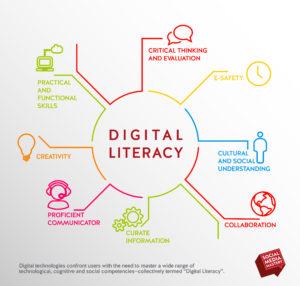
Acquiring digital skills does not just mean learning how to find one’s way successfully when navigating on the internet, but it also involves, especially in times of the Web 2.0, “how to go beyond simply creating multimodal texts to knowing how to design these texts using visual rhetoric to effectively attract, engage, and influence their audiences” (Doering et al., “Infusing Multimodal Tools and Digital Literacies into an English Education Program,” English Education 40, 1 (2007), 41-60, here: 41). In the growing complexity of various digital literacies, students need to learn how to use each of them and how to combine them.
Learning Objectives
In this lesson plan, students will learn how to combine textual and visual media with audio and video elements, acquiring the essential digitial skills working with Piktochart, iMovie, and Audacity. In a larger project, students will embedd their own digitally edited videos to their own infographics developed in Piktochart.
As such, students will learn:
- how to work with Piktochart, iMovie, and Audacity
- how to edit videos and audios
- how to combine different digital skills to produce a final product
- how critically reflect on different digital media
- how to combine different digital skills to produce a final product
- how critically reflect on different digital media
Access and Adaptability
Students ideally have access to the DWRL facilities, where they can use the computers to work with iMovie and Audacity. In addition, students ideally have access to an audio recording studio.
Assignment Description
This lesson plan is a longer project and might include multiple weeks to complete it, depending on how much time is given to students. The students will first develop the frame of their infographic with Piktochart. Second, they will download an online video (e.g. from YouTube). Third, they will record and add their own voice over to the videos. Fouth, they will edi he video with iMovie. And eventually they will add their own videos to their infographics.
For topics: students can build and expand on their 306 “controversies,” but they may also choose a new topic. This topic should have some political relevance and be controversial, i.e. make it necessary to take a specific point of view on it. This will allow critical reflection on the perspective the students took.
Instructor Preparation
- Required skills: Piktochart, iMovie, Audacity
- digital classroom with computers with iMovie and Audacity
- ideally: audio recording ‘studio’
Student Preparation
optional: watching tutorials for Piktochart, iMovie, and Audacity
In-Class or Assignment Instructions
Step 1:
– Students find a controversial topic with some political relevance, and where they have to take a certain position
– students develop a draft for their Infographic
Step 2:
-Student search for and download a short video: it may be informative and ‘fact-based’ but it can also be controversial and be opinion-based
Step 3:
– students record their own audio (with Audacity in the DWRL audio recording studio) to be used as ‘voice over’ for their videos
Step 4:
– students add their own voice over to the video and edit their videos (with iMovie)
Step 5:
-students add their videos to their infographics; special attention should be given to the differences and complementary nature of the different media: the video should complement the information on the infographic, not repeat it, etc.
Step 6:
– presentation of infographics in class; peer-review feedback possible; eventually: submission for a grade

The following DWRL produced tutorials give introductions to the digitals skills necessary for this lesson plan. The first one is a Piktochart tutorial. Video 2-3 give introductions to Audacity. And videos 4-6 show how to edit videos with iMovie.
Assessment Suggestions
While teachers may assess only the final product, they might also decide for a portfolio-style assessment which comprises the individual product elements as well as the in-class peer review and possibly an essay in which students justify their decisions.
Teachers can assess not only the final product but also the individual elements, the in-class presentation, the feedback the students give to each other as well as a final essay in which students justify their decisions.
Teachers may assess only the final product. While it may be difficult o assess the aesthetics, teachers should focus on how the different media support and complement each other with regards to the overall message.


